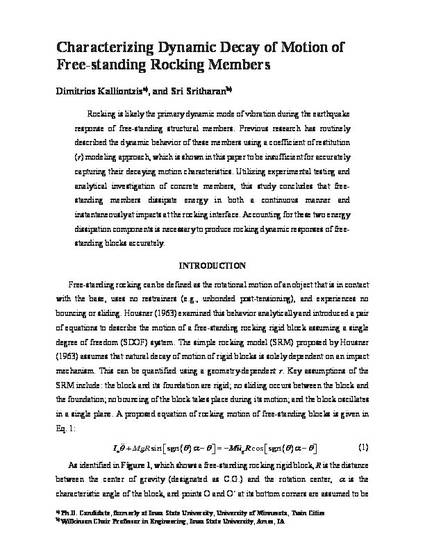
Article
Characterizing Dynamic Decay of Motion of Free-Standing Rocking Members
Earthquake Spectra
Document Type
Article
Disciplines
Publication Version
Accepted Manuscript
Publication Date
5-1-2018
DOI
10.1193/011217EQS013M
Abstract
Rocking is likely the primary dynamic mode of vibration during the earthquake response of free-standing structural members. Previous research has routinely described the dynamic behavior of these members using a coefficient of restitution (r) modeling approach, which is shown in this paper to be insufficient for accurately capturing their decaying motion characteristics. Utilizing experimental testing and analytical investigation of concrete members, this study concludes that free-standing members dissipate energy in both a continuous manner and instantaneously at impacts at the rocking interface. Accounting for these two energy dissipation components is necessary to accurately produce rocking dynamic responses of free-standing blocks.
Rights
Copyright 2018 Earthquake Engineering Research Institute. This article may be downloaded for personal use only. Any other use requires prior permission of the Earthquake Engineering Research Institute.
Copyright Owner
Earthquake Engineering Research Institute
Copyright Date
2018
Language
en
File Format
application/pdf
Citation Information
Dimitrios Kalliontzis and Sri Sritharan. "Characterizing Dynamic Decay of Motion of Free-Standing Rocking Members" Earthquake Spectra Vol. 34 Iss. 2 (2018) p. 843 - 866 Available at: http://works.bepress.com/sri_sritharan/46/

This is a manuscript of an article published as Kalliontzis, Dimitrios, and Sri Sritharan. "Characterizing Dynamic Decay of Motion of Free-Standing Rocking Members." Earthquake Spectra 34, no. 2 (2018): 843-866. doi: 10.1193/011217EQS013M. Posted with permission.